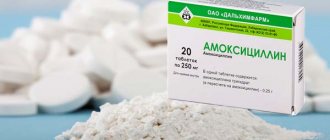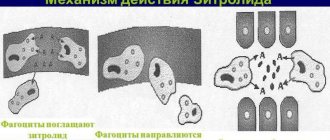Pharmacological properties of the drug Flemoklav solutab
Broad-spectrum antibiotic, active against gram-positive and gram-negative microorganisms (including strains that produce β-lactamases). Clavulanic acid, which is part of the drug, ensures the resistance of amoxicillin to the action of β-lactamases, expanding the spectrum of its antimicrobial activity. The drug is active against aerobic gram-positive bacteria: Staphylococcus aureus (including strains producing β-lactamases), Staphylococcus epidermidis (including strains producing β-lactamases) , Streptococcus pneumoniae, Streptococcus pyogenes, Streptococcus viridans, Streptococcus agalactiae, Enterecoccus faecalis, Enterococcus faec ium, Bacillus anthracis, Nocardia asteroids, Corynebacterium spp., Listeria monocytogenes; anaerobic gram-positive bacteria: Clostridium spp., Peptococcus spp., Peptostreptococcus spp.; aerobic gram-negative bacteria: Escherichia coli (including strains producing β-lactamases), Proteus mirabilis (including strains producing β-lactamases), Proteus vulgaris (including strains producing β-lactamases), Neisseria menengitidis, Neisseria gonorrhoeae (including strains producing β-lactamases), Moraxella catarrhalis (Branhamella catarrhalis), Haemophilus influenzae (including strains producing β-lactamases), Haemophilus ducreyi (including strains producing β-lactamases), Helicobacter pylori, Klebsiella spp. (including strains producing β-lactamases), Salmonella spp. (including strains producing β-lactamases), Shigella spp. (including strains producing β-lactamases), Bordetella pertussis, Yersinia enterocolitica (including strains producing β-lactamases), Gardnerella vaginalis, Brucella spp., Pasteurella multocida, Legionella spp., Campylobacter jejuni, Vibrio cholerae; anaerobic gram-negative bacteria: Bacteroides spp., including Bacteroides fragilis (including strains producing β-lactamases) , Fusobacterium spp.; other microorganisms: Borrelia burgdorferi, Leptospira icterohaemorrhagiae, Treponema pallidum. Amoxicillin The absolute bioavailability of amoxicillin is dose dependent and varies up to approximately 94%. Bioavailability when used in the dose range of 250–750 mg is directly proportional to the dose. As the dose increases, the degree of absorption decreases. Absorption is independent of food intake. The maximum concentration in blood plasma is achieved 1–2 hours after administration. After a single dose of 500/125 mg amoxicillin/clavulanic acid, the average amoxicillin concentration after 8 hours is 0.3 mg/l. The volume of distribution is 0.3–0.4 l/kg body weight, the degree of binding to plasma proteins is 17–20%. Amoxicillin is excreted mainly in the urine (52±15% unchanged within 7 hours), a small amount is excreted in the bile. The total clearance is 250–370 ml/min. The half-life from the blood serum in patients with impaired renal function is about 1 hour (0.9–1.2 hours), and in anuria it is 10–15 hours. It is eliminated by hemodialysis. Clavulanic acid The absolute bioavailability of clavulanic acid is about 60%. Absorption is independent of food intake. The maximum concentration of clavulanic acid in the blood serum is achieved approximately 1–2 hours after oral administration. After a single dose of 500/125 mg of amoxicillin/clavulanic acid, the concentration of clavulanic acid in the blood serum reaches 0.08 mg/l after 8 hours. The volume of distribution is about 0.2 l/kg body weight, binding to plasma proteins is approximately 22%. Clavulanic acid penetrates the placental barrier. No penetration into breast milk was observed. About 40% is excreted in the urine (18–38% unchanged). The total clearance is about 260 ml/min. The half-life in patients with impaired renal function is about 1 hour, with anuria - 3-4 hours. It is eliminated by hemodialysis. Therapeutic concentrations of both substances are achieved in the gall bladder, abdominal tissues, skin, subcutaneous fat and muscle tissue, as well as in synovial and peritoneal fluid, bile and pus.
Indications for use of the drug Flemoklav solutab
Infections of the upper and lower respiratory tract (acute and chronic bronchitis, lobar pneumonia, bronchopneumonia, pleural empyema, lung abscess) and ENT organs (including otitis media, sinusitis, tonsillitis, pharyngitis); bacterial infections of the skin and soft tissues (including abscess, wound infection); infections of the genitourinary system (including cystitis, urethritis, pyelonephritis, salpingitis, salmetritis, bacterial vaginitis, septic abortion, postpartum sepsis, pelvioperitonitis, chancroid, gonorrhea); osteomyelitis, sepsis, intra-abdominal infections, peritonitis, postoperative infections.
Use of the drug Flemoklav solutab
To reduce the severity of dyspeptic symptoms, take before meals. The tablet is swallowed whole, chewed with a glass of water, or dissolved in 1/2 glass of water (at least 30 ml). The duration of treatment depends on the severity of the infection and should not exceed 14 days without reviewing the clinical situation. Adults and children weighing more than 40 kg are prescribed 1 tablet 500/125 mg 2-3 times a day or 875/125 mg 2 times a day. The daily dose for children aged 2–12 years (body weight 13–37 kg) is 20–30 mg of amoxicillin and 5–7.5 mg of clavulanic acid per 1 kg of body weight. For children aged 2-7 years (body weight - 13-25 kg), a single dose is 125/31.25 mg with a dosage frequency of 2-3 times a day; for children aged 7–12 years (body weight 25–37 kg), a single dose is 250/62.5 mg with a dosage frequency of 2–3 times a day. For more severe infections, these doses can be doubled (the maximum daily dose is 60 mg of amoxicillin and 15 mg of clavulanic acid per 1 kg of body weight). In patients with impaired renal function, the elimination of clavulanic acid and amoxicillin is slowed down. Depending on the severity of renal failure, the dose of the drug should not exceed those given in the table.
Glomerular filtration rate, ml/min | Adults | Children |
| 10–30 | 500/125 mg 2 times a day | — |
| ≤10 | 500/125 mg per day | — |
| Hemodialysis | 500/125 mg per day and 500 mg during and after hemodialysis | 15 mg/kg per day and 15 mg/kg during and after hemodialysis |
Flemoclav Solutab at a dose of 875/125 mg can be prescribed only with a glomerular filtration rate of 30 ml/min, and there is no need for dose adjustment. In patients with impaired liver function, the amoxicillin/clavulanic acid combination is prescribed with caution during continuous monitoring of liver function.
Overdose
Symptoms
Gastrointestinal symptoms and water and electrolyte imbalance may occur. Amoxicillin crystalluria has been described, in some cases leading to the development of renal failure (see section "Special instructions and precautions").
Convulsions may occur in patients with impaired renal function, as well as in those who receive high doses of the drug (see section “Dosage and Administration” - Patients with impaired renal function, “Side effects”).
Treatment
Gastrointestinal symptoms - symptomatic therapy, paying special attention to normalizing water and electrolyte balance. Amoxicillin and clavulanic acid can be removed from the bloodstream by hemodialysis.
The results of a prospective study that was conducted in 51 children at a poison control center showed that amoxicillin administered at a dose of less than 250 mg/kg did not lead to significant clinical symptoms and did not require gastric lavage.
Contraindications to the use of the drug Flemoklav solutab
Hypersensitivity to amoxicillin, clavulanic acid and other components of the drug, as well as to other β-lactam antibiotics (penicillins, cephalosporins); a history of development of jaundice or impaired liver function after taking amoxicillin or clavulanic acid; children weighing up to 13 kg (due to the difficulty of precise dosing). In patients with mononucleosis or lymphocytic leukemia, the risk of developing a rash increases, therefore the combination of amoxicillin/clavulanic acid is not prescribed for these diseases. In patients with infectious mononucleosis or lymphocytic leukemia, the risk of exanthema increases, therefore, the combination of amoxicillin/clavulanic acid is not recommended for these diseases.
Release form
Tablets are white or straw-colored, oblong, engraved with “425” and the company logo; There may be isolated brown spots.
7 tablets of the antibiotic Flemoklav Solutab with a total mass of active ingredients of 1000 mg ( amoxicillin 875 mg + clavulonic acid 125 mg) are enclosed in a blister, 2 such blisters in a paper package.
Tablets of other dosages are enclosed in blisters of 4 pieces, 5 such blisters in paper packaging.
Side effects of the drug Flemoklav solutab
They develop rarely and are usually mild and transient in nature. Allergic reactions: urticaria, maculopapular rash. In some cases, a so-called five-day rash (measles-like rash) develops. The severity of the reaction depends on the dose of the drug and the patient's condition. from the gastrointestinal tract: nausea, vomiting, diarrhea, impaired liver function (increased activity of transaminases, alkaline phosphatase and bilirubin levels in the blood serum), which are more often observed in men and people over the age of 65 years (develops extremely rarely in children). The risk of side effects increases when using the drug for more than 14 days. Symptoms occur during treatment or immediately after stopping it, but in some cases they may appear several weeks after stopping the drug. Side effects from the gastrointestinal tract are usually transient and minor, but sometimes they are pronounced. Below is the frequency of side effects from different organs and systems: Often From the gastrointestinal tract: nausea, vomiting, diarrhea, abdominal pain; from the immune system: type I hypersensitivity reactions (urticaria, purpura); on the skin: rash. Rarely From the blood system: changes in the cellular composition of peripheral blood (leukopenia, thrombocytopenia, hemolytic anemia), increased prothrombin time and increased bleeding time; from the hepatobiliary system: hepatitis, including cholestatic; from the immune system: serum sickness, angioedema, vasculitis; from the nervous system: dizziness, headache, convulsions (in case of impaired renal function or overdose); from the psyche: transient increased activity; from the kidneys and urinary tract: interstitial nephritis. Isolated cases: Pseudomembranous colitis, anaphylactic reactions, various forms of erythema (including Stevens-Johnson syndrome), exfoliative bullous dermatitis (including toxic epidermal necrolysis).
Special instructions for the use of the drug Flemoklav solutab
Elderly patients do not require dosage adjustment. The drug is prescribed with caution to patients with impaired liver function. Liver function must be constantly monitored. There is a possibility of developing cross-resistance of microorganisms to other penicillins or cephalosporins. As with other broad-spectrum penicillins, superinfections may occur, especially in patients with chronic diseases and/or immune system dysfunction. For persistent diarrhea, possible pseudomembranous and hemorrhagic colitis, appropriate measures should be taken. The use of antiperistaltic agents is contraindicated. In patients with impaired renal function, the dose of the drug must be selected taking into account the severity of the condition. In patients with impaired liver function, the amoxicillin/clavulanic acid combination should be administered with caution and under constant medical supervision. Flemoclav Solutab should not be used for more than 14 days without assessing liver function. An increase in prothrombin time is rarely noted. Amoxicillin/clavulanic acid should be administered with caution to patients receiving anticoagulants. It is necessary to consider the possibility of developing fungal or bacterial superinfection during therapy. If superinfection develops, stop taking the drug and prescribe appropriate therapy. Due to the high concentration of amoxicillin in the urine, it can settle on the walls of the urinary catheter, so such patients need to change the catheter promptly. Forced diuresis accelerates the elimination of amoxicillin and reduces its serum concentration. Non-enzymatic methods for determining blood glucose, as well as the urobilinogen test, may give false positive results. If seizures occur during therapy, stop taking the drug. One dispersed tablet Flemoklav Solutab 875/125 mg contains 25 mg of potassium. During pregnancy and breastfeeding. When using the combination of amoxicillin/clavulanic acid during pregnancy, no negative effects on the fetus or newborn were observed. In a single study, prophylactic amoxicillin/clavulanic acid in women with premature rupture of membranes increased the risk of necrotizing enterocolitis in the newborn. Use in the second and third trimester of pregnancy is possible after a doctor has assessed the benefit/risk ratio of treatment. During the first trimester of pregnancy, the combination of amoxicillin/clavulanic acid at a dose of 875/125 mg should be avoided. Both components of the drug penetrate the placental barrier and are excreted into breast milk (there is no data on the effect of clavulanic acid on a breastfed baby). It is possible to use the drug during breastfeeding. However, if the child develops diarrhea or a fungal infection of the mucous membranes, breastfeeding must be stopped. It is also necessary to take into account the possibility of sensitization of the child by the components of the drug during breastfeeding. There were no negative effects on the ability to drive vehicles or operate potentially dangerous machinery.
Helper in the fight for health
The time has long passed when the use of antibiotics was considered an out-of-the-ordinary event. Modern pharmacology can boast of the latest developments in the field of such medications.
Flemoclav Solutab and its analogues allow you to cope with various diseases and their consequences in the shortest possible time.
The only rule that all patients need to remember is that antibiotics require strict dosage.
And then they will bring only benefits, without any side effects.
Interactions of the drug Flemoklav solutab
Antacids, glucosamine, laxatives, aminoglycosides slow down and reduce, and ascorbic acid increases the absorption of the drug components. Flemoklav Solutab should not be prescribed simultaneously with bacteriostatic drugs (tetracyclines, macrolides or chloramphenicol), especially in acute infections. A synergistic effect is possible when administered simultaneously with aminoglycosides, cephalosporins, cycloserine, rifampicin, vancomycin. Medicines that inhibit the release of amoxicillin (probenecid, phenylbutazone, oxyphenbutazone and, to a lesser extent, acetylsalicylic acid, indomethacin and sulfinpyrazone) contribute to a longer presence of amoxicillin in the blood plasma. Flemoklav Solutab is not used in combination with probenecid. The use of allopurinol and amoxicillin increases the risk of rash. Amoxicillin is prescribed with caution in combination with disulfiram. The combined use of amoxicillin and digoxin causes an increase in the level of digoxin in the blood plasma. The drug reduces the effectiveness of oral contraceptives. Diuretics, allopurinol, phenylbutazone, NSAIDs and other drugs that block tubular secretion increase the concentration of amoxicillin in the blood. When used simultaneously with anticoagulants, medical supervision of the patient is necessary, since this increases the prothrombin time.
What is the composition
According to the attached instructions, the medicine “Flemoclav” contains two active substances - amoxicillin and clavulonic acid. It is this combination that allows the drug to exhibit maximum effectiveness against most pathogenic microorganisms.
Dispersed cellulose and MCC, vanillin and crospovidorn, tangerine and lemon flavor, as well as saccharin and magnesium stearate are the auxiliary components of the drug. Their task is to optimally support the medicinal properties of the drug.






